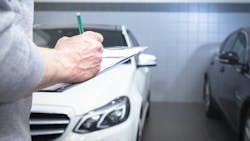In February's part 2 of the blueprinting series, we discussed the need for a written process to follow, blueprint teams, vehicle check in and parts carts.
After the vehicle has been test-driven, checked in, unrelated prior damage (UPD) documented, pre-scanned, necessary photos confirmed, parts carts staged, and estimate file tabs completed, we still can’t start disassembly! Did we preorder any parts? If so, they need to be brought to the vehicle. I shouldn’t need to say this one, but never bring a car into Blueprint without having a signed "Authorization to repair" from the owner. My shop has a "No signed authorization, no start" policy, period!
Do You Know if the Vehicle is Repairable?
One more thing that every shop struggles with, including mine, is a possible total loss. There is nothing much worse for the shop and the customer experience than to have a non-drive sit in the parking lot for three to four weeks and then bring the car in, to find out only it is a total after a blueprint. I can hear what some of you are thinking. “Greg, I love them, as we make a ton on total loss charges.” Granted, that may be true, but I only want cars being blueprinted we are going to repair. Fixing cars should be our goal, or at least it’s mine, anyway. There are times pre-writing a parking lot estimate is necessary to prevent this time bandit.
While the tech was busy checking the car in, setting up parts carts, mapping the windshield etc., the writer after confirming estimate tabs, photos etc. are completed should be building the estimate with some of the major components simultaneously. After the writer has prebuilt the estimate, they can then be looking at OEM inspections & procedures. I understand, some of these can be over 800 pages long. There is some software out now (and in the works) to save time by reading the estimate for needed procedures. They are not perfect but can be helpful.
The Process for Removing Damaged and R&I Parts
Without listing every step in our blueprint process, we are now ready for the tech to start removing the damaged & R&I parts. When a tech removes, say, a foglamp, it's placed on the table next to the writer. The writer then photographs the part and enters it into the estimate as either "R&I" or "replace." R&I foglamp goes on the R&I-Cart or damaged foglamp goes in the Red-Cart. Please read this carefully: Every removed part goes through this process at my shop; it doesn’t matter if it’s a radiator or mudflap. This is about as visual as you can get. The writer is the only one who can place the parts on the two carts. Obviously, the tech is fully capable, but this ensures everything is entered on the estimate. R&Is are a huge profit center, and thousands of R&I are missed every day in shops.
We bag and tag every fastener and label every bag. Our bags are attached to chip clips tied to the side of every cart. You can even number the bags, as an example: Camry/Frt Cvr R&I/ No.1., Camry/Frt Cvr OH (overhaul) /No. 2. This way, the bottom bag on the chip clip is the last bag you need to grab in reassembly when reattaching the front cover.
Blend or No Blend?
Built in our process is all blend/no blend decisions are made. Necessary OEM inspections are done now. Mike Anderson has taught me well by using the "Tell, don’t ask" policy with insurers. This means we don’t have time to wait for approval from an insurer to do a procedure or not. If we know we need to do it, approval or not, prove it done with photos, then they know we did it and there is no chance of fraud from work approved by an insurer but not done by the shop. Also, be very observant of one time use bolts, fasteners, interior trims, glass etc. These can be found in OEM procedures, and some are even listed in the estimating software.
Pre-measure to Locate Damage and Avoid Downstream Supplements
Lastly, back to what Steve Trapp said in part 1 about the “question mark removal department.” How far do we need to go to prevent downstream supplements and find all the damage? Do we need to pre-measure this vehicle? Probably 50%+ of the accident vehicles need a pre-measurement, but probably fewer than 10% get one and leave with damage. As far as what parts to remove, well, it's every part that needs to be removed. This means suspension, cooling, interior, seatbelts, glass, airbags, etc. I know some are saying, “You don’t understand, Greg. I just don’t have the room or enough bays," or this or that. I have worked in as bad or good conditions as anyone reading this, trust me. If we want to give the customer a great experience after a car accident, have a culture where the work is fun, make a 20%+ net profit, and we must use the brain God gave us and figure it out.
